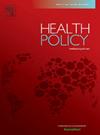COVID-19疫苗接受和使用的不平等:对13个国家COVID-19疫苗接受和使用的重复横断面分析。
IF 3.6
3区 医学
Q1 HEALTH CARE SCIENCES & SERVICES
引用次数: 0
摘要
背景:COVID-19疫苗犹豫是通过大规模免疫结束大流行的主要障碍。评估在声明的COVID-19疫苗接受(犹豫)和接受方面社会经济不平等的程度和差异。方法在13个国家进行在线调查,分别收集了15337名和18189名受访者的数据。该调查比较了报告的疫苗接受程度(2020-21年测量)和随后在2022年接种疫苗的社会经济不平等。使用差异、比率和埃雷格斯调整浓度指数对不平等进行量化。使用回归分解方法来识别与不平等相关的因素。结果平均接受率为87%,接受率为77%。最富有的五分之一和最贫穷的五分之一之间的差距在接受程度上高达23个百分点,在接受程度上高达30个百分点,两者都是在法国观察到的。在大多数国家,接受和吸收是有利于富人的(倒退的)。9个国家在接受程度上存在亲富人的不平等,8个国家在接受程度上存在不平等。在澳大利亚、中国、印度和美国,接受的退化程度明显小于接受。澳大利亚和哥伦比亚是仅有的疫苗接种率有利于穷人(渐进)的国家。在两次浪潮中,一些国家的年龄、婚姻状况和政治意识形态与社会经济不平等有关,性别和教育程度与接受程度有关,健康水平与接受程度有关。结论:我们发现各国在疫苗接种接受和接受方面存在显著的不平等,但疫苗接种的不平等程度普遍低于接受程度。这表明,如果有适当的政策来克服犹豫和减少不平等,不平等可以随着时间的推移而减少。本文章由计算机程序翻译,如有差异,请以英文原文为准。
Inequality in COVID-19 vaccine acceptance and uptake: A repeated cross-sectional analysis of COVID vaccine acceptance and uptake in 13 countries
Background COVID-19 vaccine hesitancy was a key barrier to ending the pandemic via mass immunisation.
Objectives Assess magnitudes and differences in socioeconomic inequality in stated COVID-19 vaccine acceptance (hesitancy) and uptake.
Methods Online surveys were conducted in 13 countries, collecting data from 15,337 and 18,189 respondents respectively. The investigation compares socioeconomic inequality in reported vaccine acceptance, measured in 2020–21 and subsequent uptake of vaccination in 2022. Inequalities are quantified using differences, ratios and the Erreygers adjusted concentration index. A regression decomposition approach is used to identify factors associated with inequality.
Results Mean uptake levels were 87 %, while acceptance was lower at 77 %. The difference between the richest and the poorest quintile was as large as 23 percentage points in acceptance and 30 p.p. in uptake, both observed in France. Acceptance and uptake were pro-rich (regressive) in most countries. Nine countries reported pro-rich inequality in acceptance, and eight in uptake. Uptake was significantly less regressive than acceptance in Australia, China, India, and USA. Australia and Colombia were the only countries where vaccination uptake was pro-poor (progressive). Age, marital status and political ideology were correlated with socioeconomic inequalities in several countries in both waves, while gender and education were associated with acceptance, and health levels with uptake.
Conclusion We found significant inequalities in vaccination acceptance and uptake across countries but inequality was generally lower in vaccine uptake than in acceptance. This suggests that inequalities can be reduced over time if adequate policies are in place to overcome hesitancy and reduce inequalities.
求助全文
通过发布文献求助,成功后即可免费获取论文全文。
去求助
来源期刊

Health Policy
医学-卫生保健
CiteScore
6.40
自引率
6.10%
发文量
157
审稿时长
3-8 weeks
期刊介绍:
Health Policy is intended to be a vehicle for the exploration and discussion of health policy and health system issues and is aimed in particular at enhancing communication between health policy and system researchers, legislators, decision-makers and professionals concerned with developing, implementing, and analysing health policy, health systems and health care reforms, primarily in high-income countries outside the U.S.A.
 求助内容:
求助内容: 应助结果提醒方式:
应助结果提醒方式:


